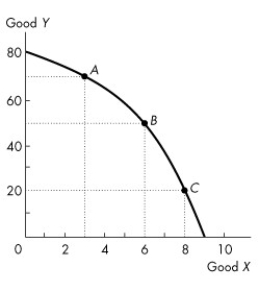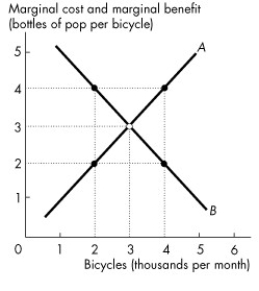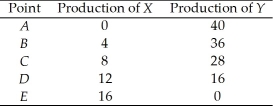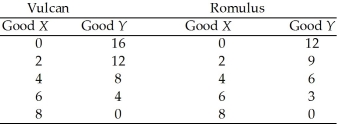A) England has an absolute advantage in wine production.
B) Portugal has an absolute advantage in wool production.
C) Portugal has a comparative advantage in wine production.
D) Portugal has a comparative advantage in wool production.
E) no trade will occur.
Correct Answer

verified
Correct Answer
verified
Multiple Choice
Jane produces only corn and cloth.If her preferences for corn and cloth change,then ________.
A) her PPF becomes steeper
B) her PPF becomes flatter
C) her PPF becomes straighter
D) the world PPF shifts outward
E) her PPF does not change
Correct Answer

verified
Correct Answer
verified
Multiple Choice
Use the figure below to answer the following questions.
 Figure 2.1.2
-Consider the production possibilities frontier in Figure 2.1.2,and assume that everything that is produced is also consumed.Which of the following statements is false?
Figure 2.1.2
-Consider the production possibilities frontier in Figure 2.1.2,and assume that everything that is produced is also consumed.Which of the following statements is false?
A) Resources are not equally useful in all activities.
B) Points inside the frontier indicate unused or misallocated resources.
C) Starting at point A, an increase in the production of Y will shift the frontier outward.
D) The opportunity cost of producing Y increases as production of Y increases.
E) The opportunity cost of producing X increases as production of X increases.
Correct Answer

verified
Correct Answer
verified
Multiple Choice
A tradeoff exists when
A) we move from a point within the production possibilities frontier (PPF) to a point on the PPF.
B) we move from a point on the PPF to a point within the PPF.
C) the PPF shifts outward.
D) we move along the PPF.
E) the PPF shifts towards the origin.
Correct Answer

verified
Correct Answer
verified
Multiple Choice
Use the figure below to answer the following questions.
 Figure 2.2.1
-In Figure 2.2.1,when 2,000 bicycles are produced each month
Figure 2.2.1
-In Figure 2.2.1,when 2,000 bicycles are produced each month
A) the marginal benefit from another bicycle is greater than the marginal cost of another bicycle.
B) more bicycles must be produced to reach the efficient level of output.
C) fewer bicycles must be produced to reach the efficient level of output.
D) the economy is efficient at this level of production of bicycles.
E) both A and B.
Correct Answer

verified
Correct Answer
verified
Multiple Choice
Use the table below to answer the following questions.
Table 2.1.1
The following table gives points on the production possibilities frontier for goods X and Y.
 -From the data in Table 2.1.1 we can infer that
-From the data in Table 2.1.1 we can infer that
A) the economy illustrated has a comparative advantage in the production of Y.
B) the economy illustrated has a comparative advantage in the production of X.
C) the opportunity cost of producing an additional unit of Y increases as the production of Y increases.
D) the opportunity cost of producing an additional unit of Y decreases as the production of Y increases.
E) none of the above.
Correct Answer

verified
Correct Answer
verified
Multiple Choice
Use the figure below to answer the following questions.
Table 2.4.1
The planets of Vulcan and Romulus each produce goods X and Y.
The following table gives points on their production possibilities frontiers.
 -Refer to Table 2.4.1.For Vulcan,the opportunity cost of producing an additional unit of Y is
-Refer to Table 2.4.1.For Vulcan,the opportunity cost of producing an additional unit of Y is
A) 2/3 units of X.
B) 1/2 units of X.
C) 2 units of X.
D) 3 units of X.
E) 4 units of X.
Correct Answer

verified
Correct Answer
verified
Multiple Choice
Use the information below to answer the following questions. Fact 2.4.1 In an eight-hour day, Andy can produce either 24 loaves of bread or 8 kilograms of butter. In an eight-hour day, Rolfe can produce either 8 loaves of bread or 8 kilograms of butter. -Consider Fact 2.4.1.After specialization,total consumption will
A) depend on the preferences of Andy and Rolfe.
B) be 8 loaves of bread and 24 kilograms of butter.
C) be 32 loaves of bread and 16 kilograms of butter.
D) be 8 loaves of bread and 8 kilograms of butter.
E) be 24 loaves of bread and 8 kilograms of butter.
Correct Answer

verified
Correct Answer
verified
Multiple Choice
It pays for people to specialize and trade with each other because
A) otherwise they would not survive.
B) they can take advantage of the fact they have an absolute advantage in the production of something.
C) this way they can consume outside their production possibilities frontier.
D) this way the strong can exploit the weak.
E) all of the above.
Correct Answer

verified
Correct Answer
verified
Multiple Choice
Use the figure below to answer the following questions.
 Figure 2.1.2
-Refer to the production possibilities frontier in Figure 2.1.2.If 6 units of X are currently being produced,then
Figure 2.1.2
-Refer to the production possibilities frontier in Figure 2.1.2.If 6 units of X are currently being produced,then
A) 40 units of Y cannot be produced unless production of X is decreased.
B) 40 units of Y cannot be produced unless production of X is increased.
C) 60 units of Y can be produced with some resources not fully used.
D) 50 units of Y must be produced, regardless of resource utilization.
E) 50 units of Y can be produced if all resources are used and assigned to the task for which they are the best match.
Correct Answer

verified
Correct Answer
verified
Multiple Choice
A movement along the production possibilities frontier will result from
A) technological change.
B) change in the stock of capital.
C) change in the labour force.
D) all of the above.
E) none of the above.
Correct Answer

verified
Correct Answer
verified
Multiple Choice
A medical clinic has 10 workers.Each worker can produce a maximum of either 2 units of medical services or 5 units of secretarial services a day.One day,the firm decides it would like to produce 16 units of medical services and 5 units of secretarial services.This output level is
A) efficient.
B) unattainable.
C) inefficient.
D) costless.
E) attainable and efficient.
Correct Answer

verified
Correct Answer
verified
Multiple Choice
The most anyone is willing to pay for another purse is $30.Currently the price of a purse is $40,and the cost of producing another purse is $50.The marginal benefit from a purse is ________.
A) $40
B) $50
C) $10
D) $20
E) $30
Correct Answer

verified
Correct Answer
verified
Multiple Choice
The depletion of fish stocks in Eastern Canada,with its accompanying unemployment,will lead to a
A) movement from the existing production possibilities frontier to a point inside the production possibilities frontier.
B) shift inward of the existing production possibilities frontier and production at a point on the new PPF.
C) shift outward of the existing production possibilities frontier.
D) movement along the existing production possibilities frontier to a point of less fish production.
E) shift inward of the existing production possibilities frontier plus a movement to a point inside the new production possibilities frontier.
Correct Answer

verified
Correct Answer
verified
Multiple Choice
The opportunity cost of pushing the production possibilities frontier outward is
A) capital accumulation.
B) technological change.
C) reduced current consumption.
D) the gain in future consumption.
E) all of the above.
Correct Answer

verified
Correct Answer
verified
Multiple Choice
Use the information below to answer the following questions. Fact 2.4.2 Agnes can produce either 1 unit of X or 1 unit of Y in an hour, while Brenda can produce either 2 units of X or 4 units of Y in an hour. -Any two individuals will gain from exchange
A) unless one has an absolute advantage in producing all goods.
B) if each specializes in the production of the good for which he has the higher opportunity cost.
C) unless they have the same opportunity costs for producing all goods.
D) unless they have different opportunity costs for producing all goods.
E) unless they have the same absolute advantage in producing all goods.
Correct Answer

verified
Correct Answer
verified
Multiple Choice
Use the information below to answer the following questions. Fact 2.4.1 In an eight-hour day, Andy can produce either 24 loaves of bread or 8 kilograms of butter. In an eight-hour day, Rolfe can produce either 8 loaves of bread or 8 kilograms of butter. -Refer to Fact 2.4.1.The opportunity cost of producing 1 kilogram of butter is
A) 20 minutes (1/3 hour) for Andy and 1 hour for Rolfe.
B) 1 hour for Andy and 1 hour for Rolfe.
C) 3 loaves of bread for Andy and 1/3 loaf of bread for Rolfe.
D) 3 loaves of bread for Andy and 1 loaf of bread for Rolfe.
E) 8 loaves of bread for Rolfe and 24 loaves of bread for Andy.
Correct Answer

verified
Correct Answer
verified
Multiple Choice
Use the figure below to answer the following questions.
Table 2.4.1
The planets of Vulcan and Romulus each produce goods X and Y.
The following table gives points on their production possibilities frontiers.
 -Refer to Table 2.4.1.Which one of the following is true?
-Refer to Table 2.4.1.Which one of the following is true?
A) Romulus has both an absolute advantage and a comparative advantage in the production of Y.
B) Romulus has both an absolute advantage and a comparative advantage in the production of X.
C) Vulcan has a comparative advantage in the production of X.
D) Romulus has a comparative advantage in the production of X.
E) Vulcan should specialize in the production of X.
Correct Answer

verified
Correct Answer
verified
Multiple Choice
The growth of capital resources,including human capital is
A) technological change.
B) capital accumulation.
C) depreciation.
D) opportunity cost.
E) none of the above.
Correct Answer

verified
Correct Answer
verified
Multiple Choice
The development of new goods and better ways of producing goods and services is
A) capital accumulation.
B) technological change.
C) the big tradeoff.
D) allocative efficiency.
E) none of the above.
Correct Answer

verified
Correct Answer
verified
Showing 21 - 40 of 143
Related Exams